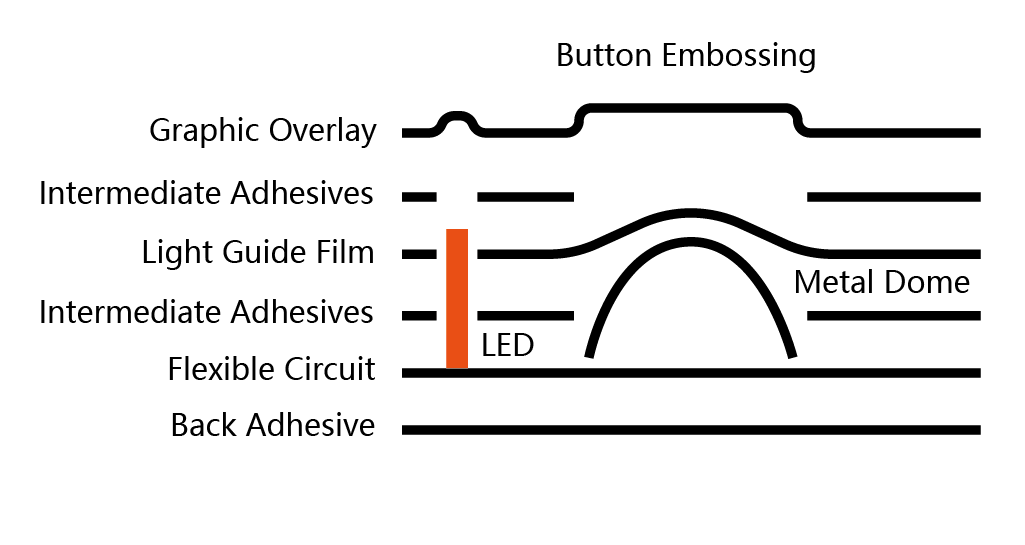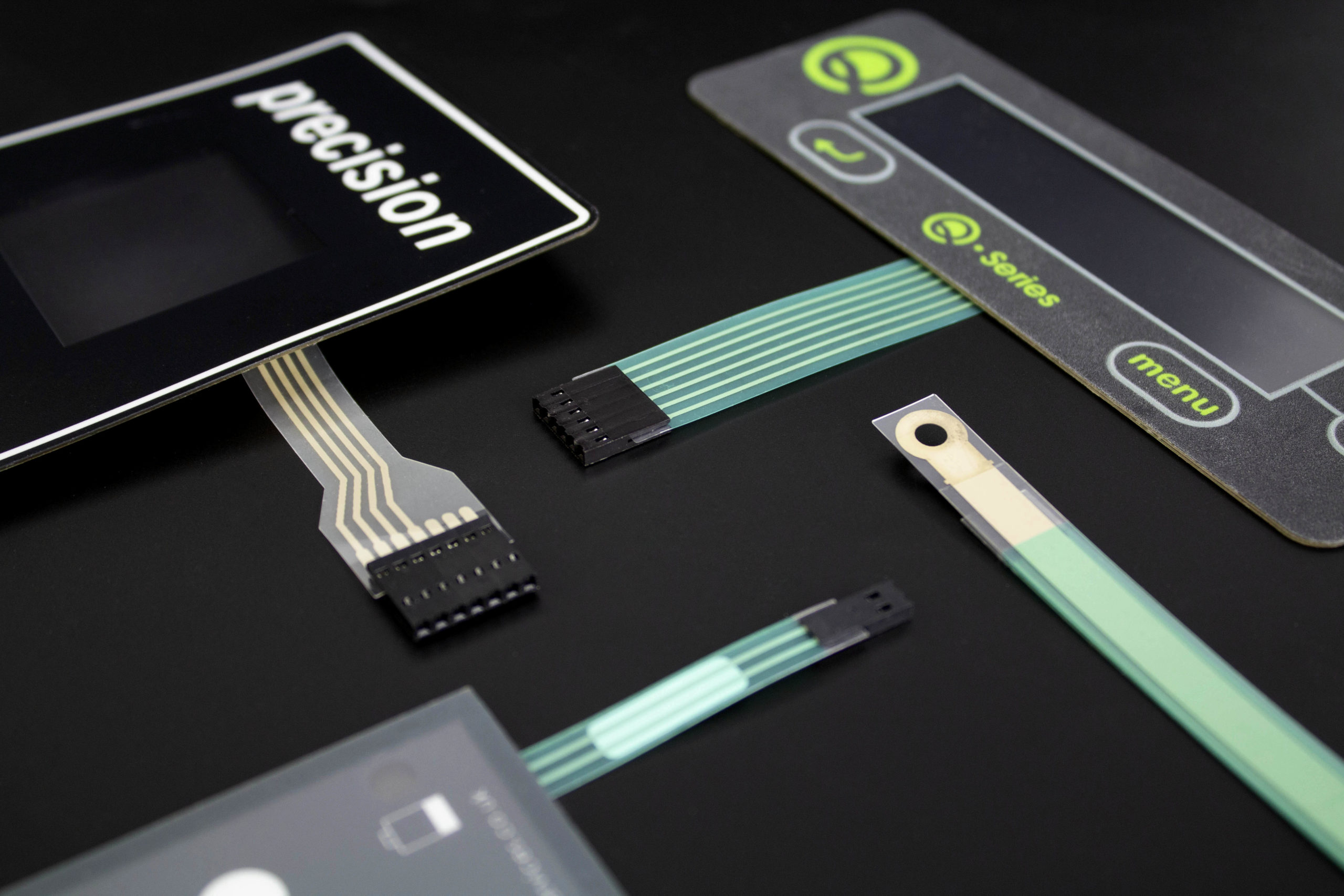All Regarding Membrane Switch: A Comprehensive Overview for Beginners
Membrane buttons are crucial parts in modern-day electronic devices, using an unique user interface for individual interaction - membrane switch. Their split building and construction, consisting of overlays and conductive traces, offers functionality and resilience. Unlike typical mechanical switches, membrane layer switches present a sleek layout and customizable alternatives. Understanding their vital features and benefits can transform item layout. The intricacies of their application and style factors to consider require more exploration.
What Is a Membrane layer Change?
A membrane layer switch is a kind of electrical switch that contains an adaptable membrane layered over a published circuit card. This style enables a smooth and portable user interface, frequently made use of in different digital gadgets. Membrane layer buttons are frequently located in consumer home appliances, clinical devices, and commercial machinery due to their longevity and resistance to environmental factors.The construction usually includes several layers, such as graphic overlays and glue backing, which offer responsive feedback and safeguard the circuitry below. The procedure of a membrane layer button is started when stress is used to the surface, completing an electric circuit.These switches are valued for their adaptability, allowing personalized designs and published graphics that provide to particular user interfaces. Their inconspicuous nature minimizes space requirements, making them optimal for applications where standard switches may not fit. Overall, membrane layer switches provide a aesthetic and practical remedy for modern electronic tools.
Key Elements of Membrane Layer Switches Over
Membrane layer changes make up numerous key elements that add to their capability and efficiency. The top layer, recognized as the overlay, gives the interface and is commonly printed with graphics or signs. Beneath the overlay exists a spacer layer, which separates the conductive aspects and prevents inadvertent activation. The following important element is the visuals layer, which boosts visual appeals and assures the longevity of the design.Conductive traces, generally made from products like silver or carbon, are published on the circuit layer. When stress is put on the overlay, these traces enter into contact, finishing the circuit. Furthermore, a backing layer offers structural support and can be made from materials such as polyester or polycarbonate. Together, these components create a reputable, user-friendly user interface suitable for different applications, from family devices to commercial equipment. Comprehending these aspects is crucial for anybody thinking about membrane layer switch innovation.
Just How Membrane Switches Over Job
Recognizing exactly how membrane switches over function is crucial for valuing their extensive use in various tools. A membrane button runs through a collection of layers, consisting of a visuals overlay, spacer, and a circuit layer. When pressure is used to the overlay, it presses the spacer layer, permitting the circuit layer to make call and finish an electric circuit. This action sends a signal to the device, triggering an action, such as switching on a light or turning on a function.Membrane switches over can be designed with various attributes, consisting of responsive responses, backlighting, and customized graphics, boosting individual communication. Their building permits a sealed layout, shielding the internal elements from dirt, moisture, and contaminants. This resilience makes them suitable for diverse applications, from customer electronics to industrial devices. Overall, the simplicity and performance of membrane layer changes contribute to their popularity in contemporary innovation.
Benefits of Membrane Layer Switches Over Over Mechanical Switches
While mechanical switches have actually long been a staple in numerous gadgets, membrane switches offer distinctive advantages that make them significantly appealing. One significant benefit is their slim account, enabling more portable styles and higher adaptability in product advancement. Additionally, membrane layer switches over function an uniform surface area, which improves aesthetic allure and simplifies cleaning, making them suitable for environments where hygiene is critical.Another advantage is their resistance to dirt and moisture. Unlike mechanical buttons, which can be compromised by ecological factors, membrane layer switches give a sealed user interface that protects versus pollutants - membrane switch. Furthermore, membrane buttons generally have a longer life-span due to fewer relocating components, resulting in improved toughness and reliability.Cost-effectiveness is additionally a significant advantage, as membrane switches can be created wholesale with lower manufacturing prices. These elements combine to position membrane layer switches as a useful choice to traditional mechanical alternatives in different applications
Common Applications of Membrane Layer Changes
Membrane buttons are widely utilized in different markets, specifically in consumer electronic devices and industrial control panels. In customer devices, they give a sleek, easy to use interface, while in commercial setups, they improve resilience and performance. Recognizing these applications highlights the flexibility and functionality of membrane layer switches in contemporary technology.
Customer Electronic Devices Gadgets
As customer electronic devices continue to advance, membrane buttons have actually become a prominent choice for a range of gadgets because of their convenience and sleek design. These switches are typically discovered in mobile phones, tablet computers, and push-button controls, where area is restricted and appearances issue. Their reduced account and personalized styles enable producers to create user-friendly interfaces that improve the total customer experience. In addition, membrane layer switches are often used in home appliances such as microwaves and coffee manufacturers, providing instinctive control alternatives while resisting moisture and dust. The toughness and reliability of membrane layer switches make them ideal for everyday consumer items, making certain durability and consistent efficiency. Generally, their integration in consumer electronic devices shows a blend of functionality and modern design.
Industrial Control Panels
The applications of membrane layer switches over expand beyond customer electronic devices, locating substantial usage in industrial control board. These switches are preferred for their longevity and resistance to rough atmospheres, making them perfect for manufacturing and procedure control settings. They supply a trustworthy interface for drivers to regulate machinery, display procedures, and change setups. Membrane buttons can be personalized to match certain operational requirements, incorporating functions like backlighting and responsive responses, improving customer experience. Their low-profile layout enables integration right into various tools, while their capability to endure spills, dirt, and extreme temperature levels guarantees long life. In general, membrane buttons contribute to efficient and risk-free operation in industrial applications, showing their versatility and efficiency in demanding atmospheres.
Considerations for Designing Membrane Changes
When developing membrane buttons, selecting the best materials is necessary to guarantee longevity and functionality. Furthermore, comprehending layer arrangement methods can significantly affect the switch's efficiency and customer experience. These factors to consider play an important role in developing effective and reputable membrane button styles.
Product Option Relevance
Material choice plays an important duty in the design and capability of membrane layer buttons. The picked materials straight influence the button's durability, tactile reaction, and general visual. Key considerations include the substratum, which have to supply architectural stability while enabling flexibility, and the graphic overlay, which needs to be resistant to web put on and ecological variables. Conductive materials visit should assure reputable electrical performance, while adhesives must supply solid bonding without endangering the switch's operation. Furthermore, compatibility with making processes and end-user atmospheres is essential; materials have to endure differing temperatures, moisture levels, and chemical exposure. Eventually, appropriate material selection not just enhances the membrane switch's performance however likewise adds to its durability and user complete satisfaction, making it a vital facet of the style procedure.

Layer Arrangement Strategies

Frequently Asked Concerns
The Length Of Time Do Membrane Layer Switches Commonly Last?
Membrane layer buttons generally have a lifespan of 1 to 5 million cycles, depending on usage and ecological conditions. Elements such as design high quality and operating regularity substantially influence their resilience and total performance longevity.

Can Membrane Switches Over Be Customized for Certain Designs?
Membrane buttons can undoubtedly be personalized to fit details designs, allowing for diverse forms, shades, and functionalities. This convenience enables makers to customize these switches to fulfill distinct visual and functional needs effectively.
What Products Are Used in Membrane Switch Building And Construction?
Membrane layer buttons are typically built using materials such as polyester, polycarbonate, and adhesive layers. These materials provide resistance, adaptability, and resilience to ecological variables, ensuring the switches function successfully in numerous applications and problems.
Are Membrane Switches Water Resistant or Immune to Dampness?
Membrane switches can be made to be moisture-resistant, making use of specialized products and finishings. Their water-proof abilities depend on construction top quality and particular applications, making it essential to examine requirements for suitable efficiency in numerous settings.
Just How Are Membrane Switches Fixed if Damaged?
Repairing damaged membrane layer changes generally includes replacing the find out affected layer or circuit. Specialists might additionally apply conductive sticky or utilize specialized repair work sets, making certain capability is restored without complete replacement of the whole button setting up. Unlike traditional mechanical switches, membrane layer switches provide a streamlined layout and adjustable choices. A membrane layer button is a type of electrical switch that is composed of a flexible membrane layer layered over a printed circuit board. The operation of a membrane layer switch is launched when pressure is used to the surface area, completing an electrical circuit.These buttons are valued for their flexibility, making it possible for custom layouts and published graphics that cater to specific customer interfaces. While mechanical switches have actually long been a staple in several devices, membrane layer switches deal distinctive benefits that make them progressively appealing. Membrane layer switches usually have a longer lifespan due to fewer relocating parts, resulting in improved resilience and reliability.Cost-effectiveness is likewise a noteworthy benefit, as membrane switches can be generated in mass with lower manufacturing prices.